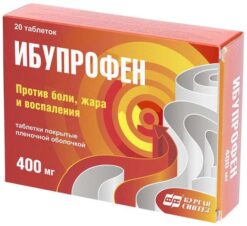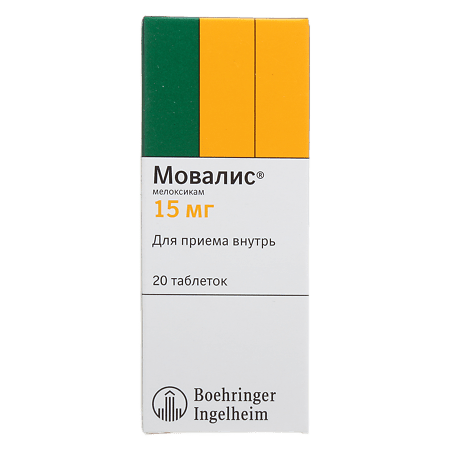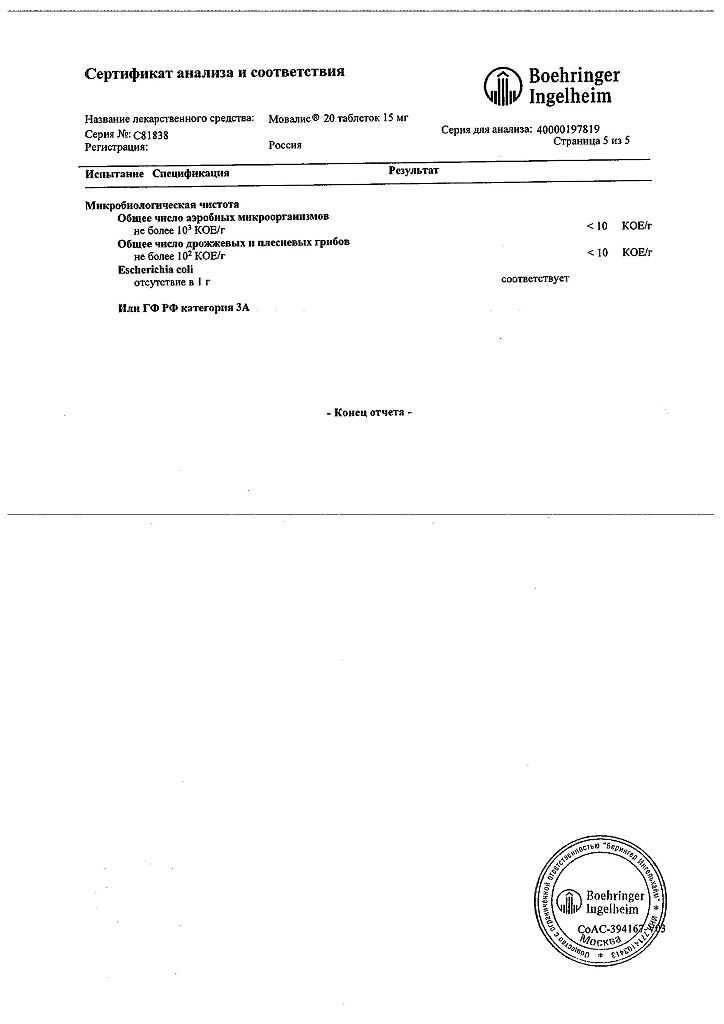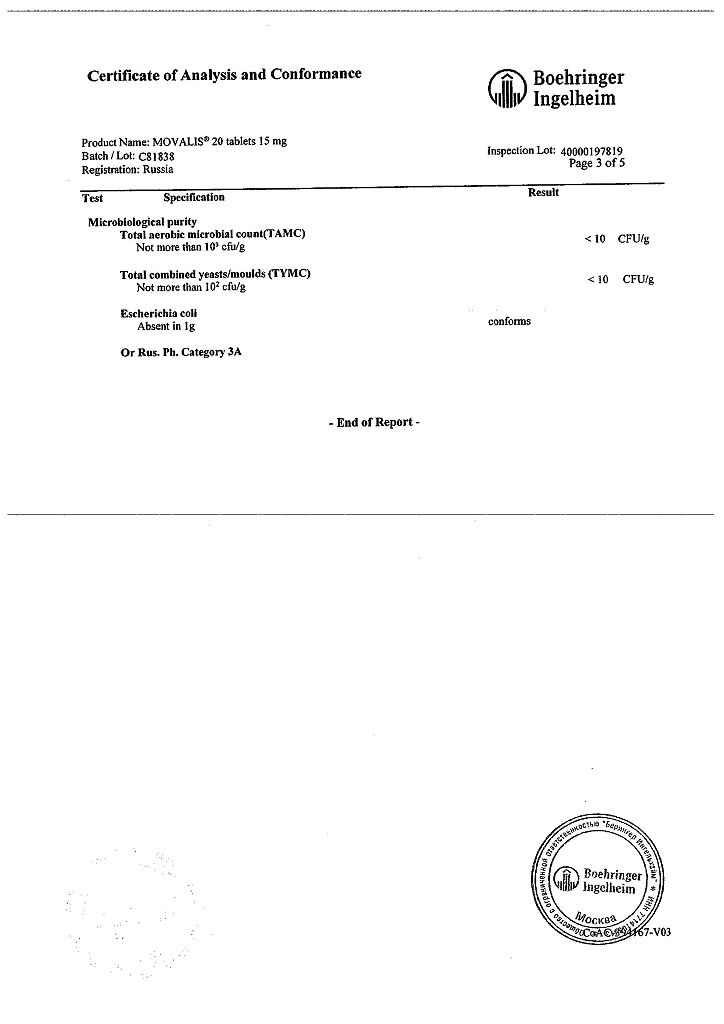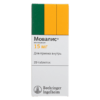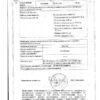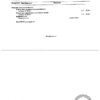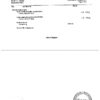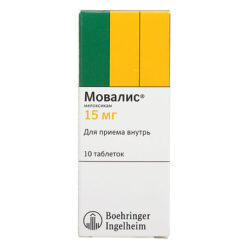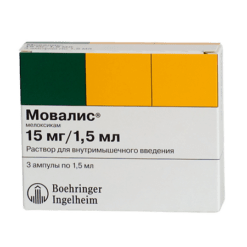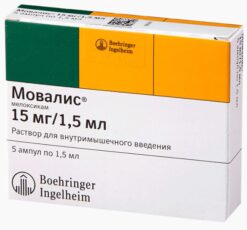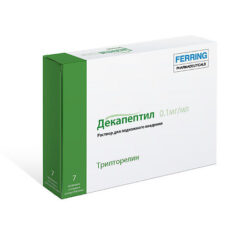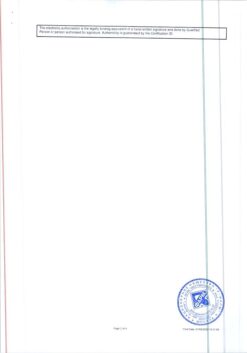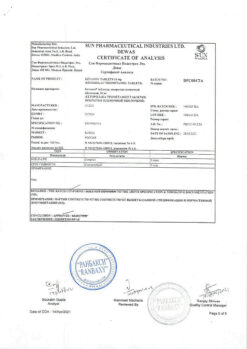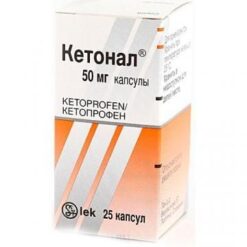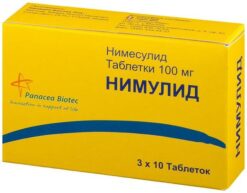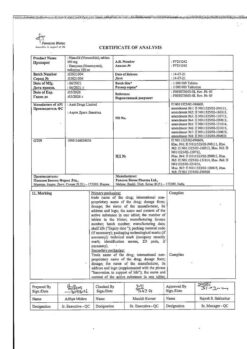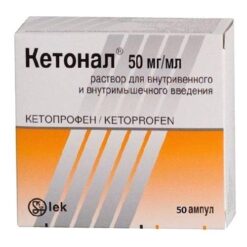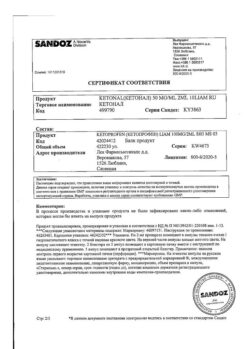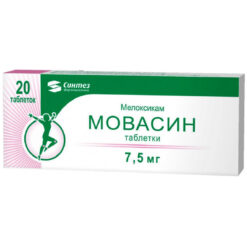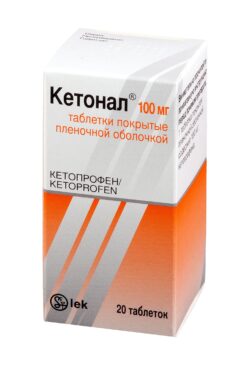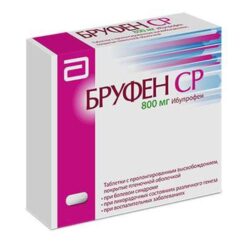Subtotal: €1.96
Movalis, tablets 15 mg 20 pcs
€26.92 €22.43
Movalis is a non-steroidal anti-inflammatory drug, refers to enolic acid derivatives and has anti-inflammatory, analgesic and antipyretic effects. The pronounced anti-inflammatory effect of meloxicam has been established in all standard models of inflammation.
The mechanism of action of meloxicam is its ability to inhibit the synthesis of prostaglandins – known mediators of inflammation.
In vivo meloxicam inhibits the synthesis of prostaglandins at the site of inflammation to a greater extent than in the gastric mucosa or kidneys.
These differences are due to more selective inhibition of cyclooxygenase-2 (COX-2) compared to cyclooxygenase-1 (COX-1). Inhibition of COX-2 is thought to provide the therapeutic effect of NSAIDs, whereas inhibition of the ever-present COX-1 isoenzyme may cause gastric and renal side effects.
The selectivity of meloxicam against COX-2 has been confirmed in various test systems, both in vitro and ex vivo. The selective ability of meloxicam to inhibit COX-2 was shown when human whole blood was used as a test system in vitro.
Ex vivo, meloxicam (at doses of 7.5 and 15 mg) was found to be more active in inhibiting COX-2, having a greater inhibitory effect on lipopolysaccharide-stimulated prostaglandin E2 production (COX-2-controlled response) than on thromboxane production involved in blood clotting (COX-1-controlled response). These effects were dose-dependent.
Ex vivo it was shown that meloxicam at the recommended doses had no effect on platelet aggregation and bleeding time, unlike indomethacin. diclofenac. ibuprofen and naproxen. which significantly inhibited platelet aggregation and increased bleeding time.
In clinical trials, gastrointestinal (GI) side effects were generally less frequent with meloxicam 7.5 and 15 mg than with the other NSAIDs compared. This difference in the frequency of gastrointestinal side effects was mainly due to the fact that dyspepsia, vomiting, nausea, and abdominal pain were less frequently observed while taking meloxicam.
The incidence of upper gastrointestinal perforations, ulcers and bleeding associated with the use of meloxicam was low and depended on the size of the drug dose.
Indications
osteoarthritis (arthrosis, degenerative joint diseases);
rheumatoid arthritis;
ankylosing spondylitis.
Pharmacological effect
Movalis is a non-steroidal anti-inflammatory drug, belongs to enolic acid derivatives and has anti-inflammatory, analgesic and antipyretic effects. The pronounced anti-inflammatory effect of meloxicam has been established in all standard models of inflammation.
The mechanism of action of meloxicam is its ability to inhibit the synthesis of prostaglandins, known mediators of inflammation.
In vivo, meloxicam inhibits prostaglandin synthesis at the site of inflammation to a greater extent than in the gastric mucosa or kidneys.
These differences are due to more selective inhibition of cyclooxygenase-2 (COX-2) compared with cyclooxygenase-1 (COX-1). Inhibition of COX-2 is thought to provide the therapeutic effect of NSAIDs, while inhibition of the constitutively present COX-1 isoenzyme may be responsible for gastric and renal side effects.
The selectivity of meloxicam for COX-2 has been confirmed in various test systems, both in vitro and ex vivo. The selective ability of meloxicam to inhibit COX-2 was demonstrated when using human whole blood as a test system in vitro.
Ex vivo it was found that meloxicam (at doses of 7.5 and 15 mg) more actively inhibited COX-2, having a greater inhibitory effect on the production of prostaglandin E2 stimulated by lipopolysaccharide (reaction controlled by COX-2) than on the production of thromboxane involved in the blood coagulation process (reaction controlled by COX-1). These effects were dose dependent.
Ex vivo it was shown that meloxicam at recommended doses did not affect platelet aggregation and bleeding time, unlike indomethacin. diclofenac. ibuprofen and naproxen. which significantly suppressed platelet aggregation and increased bleeding time.
In clinical studies, gastrointestinal (GIT) side effects were generally less common with meloxicam 7.5 and 15 mg than with other NSAIDs compared. This difference in the frequency of side effects from the gastrointestinal tract is mainly due to the fact that when taking meloxicam, such phenomena as dyspepsia, vomiting, nausea, and abdominal pain were observed less frequently.
The incidence of upper gastrointestinal perforations, ulcers and bleeding associated with meloxicam use was low and dose dependent.
Special instructions
Movalis should be used with caution in patients with concomitant diseases of the upper gastrointestinal tract, as well as in patients receiving anticoagulant therapy. If peptic ulcers or gastrointestinal bleeding occur, the drug should be discontinued.
When prescribing Movalis, the development of gastrointestinal bleeding, ulcerative lesions or perforation is possible, both if the patient has a history of previous symptoms and episodes of similar complications from the gastrointestinal tract, and without them. In old age, a more severe course of these complications is observed.
Particular attention should be paid to patients who experience undesirable effects on the skin and mucous membranes; in such cases, discontinuation of Movalis should be considered.
NSAIDs inhibit the synthesis of renal prostaglandins, which are involved in maintaining sufficient levels of renal blood flow. Prescribing NSAIDs to patients with reduced renal blood flow and volume may accelerate renal decompensation, however, after discontinuation of NSAID therapy, renal function is usually restored to its previous level.
The risk of developing adverse reactions is especially high in patients with symptoms of dehydration, congestive heart failure, liver cirrhosis, nephrotic syndrome and severe kidney disease, in patients receiving diuretics, as well as in those who have undergone significant surgery leading to hypovolemia. Such patients require careful monitoring of diuresis and renal function from the very beginning of treatment.
In rare cases, increased levels of serum transaminases or changes in other indicators of liver function have been reported. In most cases, deviations from the norm were minor and transient. If the abnormalities in liver function indicators are more pronounced or permanent, you should stop taking Movalis and carry out control laboratory tests.
In patients with clinically non-progressive liver cirrhosis, a dose reduction is not required.
Weakened and exhausted patients may experience side effects more severely and such patients require careful monitoring.
Movalis should be used with caution in elderly patients, who are more likely to have impaired renal, hepatic or cardiac function. NSAIDs may promote sodium, potassium and water retention and reduce the natriuretic effect of diuretics. As a result, in the presence of predisposing factors, the administration of NSAIDs can lead to the progression of heart failure and hypertension.
Impact on the ability to drive vehicles and operate machinery
During the treatment period, if visual acuity disturbances, dizziness or drowsiness occur, it is necessary to refrain from driving vehicles and engaging in potentially hazardous activities that require increased concentration and speed of psychomotor reactions.
Active ingredient
Meloxicam
Composition
Active ingredient:
meloxicam 15 mg;
Excipients:
sodium citrate;
lactose;
MCC;
povidone (kollidon 25),
colloidal silicon dioxide;
crospovidone;
magnesium stearate.
Contraindications
hypersensitivity to the active ingredient or auxiliary components of the drug. There is a possibility of cross-hypersensitivity to acetylsalicylic acid and other NSAIDs;
a history of symptoms of bronchial asthma, nasal polyps, angioedema or urticaria after taking acetylsalicylic acid or other NSAIDs;
peptic ulcer/perforation of the stomach and duodenum in the acute stage or recently suffered;
Crohn’s disease or ulcerative colitis in the acute stage;
severe liver failure;
severe renal failure (if hemodialysis is not performed, creatinine Cl less than 30 ml/min, as well as with confirmed hyperkalemia), progressive kidney disease;
acute gastrointestinal bleeding, recent cerebrovascular bleeding or an established diagnosis of diseases of the blood coagulation system;
severe uncontrolled heart failure;
pregnancy;
breast-feeding;
therapy of perioperative pain during coronary artery bypass surgery.
children under 12 years of age, with the exception of use for juvenile rheumatoid arthritis (if this indication is registered).
Side Effects
From the hematopoietic organs: changes in the number of blood cells, including changes in the leukocyte formula, leukopenia, thrombocytopenia, anemia. A predisposing factor for the occurrence of cytopenias appears to be the simultaneous use of potentially myelotoxic drugs, in particular methotrexate.
From the immune system: anaphylactic shock, anaphylactoid/anaphylactic reactions, other immediate hypersensitivity reactions.
From the side of the central nervous system: headache, dizziness, tinnitus, drowsiness, confusion, disorientation, mood changes.
From the gastrointestinal tract: gastrointestinal perforation, hidden or obvious gastrointestinal bleeding, possibly fatal, gastroduodenal ulcers, colitis, gastritis, esophagitis, stomatitis, abdominal pain, dyspepsia, diarrhea, nausea, vomiting, constipation, bloating, belching, transient changes in liver function tests (for example, increased activity of transaminases or bilirubin), hepatitis.
From the skin and skin appendages: toxic epidermal necrolysis, Stevens-Johnson syndrome, angioedema, bullous dermatitis, erythema multiforme, itching, skin rash, urticaria, photosensitivity.
From the respiratory system: bronchial asthma in patients with allergies to acetylsalicylic acid or other NSAIDs.
From the cardiovascular system: increased blood pressure, palpitations, flushing of the face, swelling.
From the genitourinary system: acute renal failure, changes in renal function (increased levels of creatinine and/or urea in the blood serum), urinary disorders, including acute urinary retention.
From the organ of vision: conjunctivitis, visual impairment, including blurred vision.
Interaction
Other inhibitors of PG synthesis, including GCs and salicylates, when taken simultaneously with meloxicam, increase the risk of ulceration in the gastrointestinal tract and gastrointestinal bleeding (due to synergistic action) and therefore their combination is not recommended. Concomitant use with other NSAIDs is not recommended.
SSRIs increase the risk of gastrointestinal bleeding.
Lithium preparations – NSAIDs increase the concentration of lithium in plasma by reducing its excretion by the kidneys. It is recommended to monitor the concentration of lithium during the period of administration of Movalis®, when changing the dose of lithium preparations and their discontinuation.
Methotrexate – NSAIDs reduce the tubular secretion of methotrexate, thereby increasing its plasma concentration and hematological toxicity, but the pharmacokinetics of methotrexate does not change. In this regard, simultaneous use of Movalis® and methotrexate at a dose of more than 15 mg/week is recommended. The risk of interaction between NSAIDs and methotrexate may also occur in patients using low doses of methotrexate, especially in patients with impaired renal function. Therefore, constant monitoring of the number of blood cells and kidney function is necessary.
Concomitant use of meloxicam did not affect the pharmacokinetics of methotrexate at a dose of 15 mg per week, however, it should be taken into account that the hematological toxicity of methotrexate is enhanced by concomitant use of NSAIDs.
When meloxicam and methotrexate are used together for 3 days, the risk of increased toxicity of the latter increases.
Contraception – NSAIDs reduce the effectiveness of intrauterine contraceptive devices.
Diuretics – the use of NSAIDs in case of dehydration of patients is accompanied by the risk of developing acute renal failure.
Adequate hydration should be maintained in patients receiving Movalis® and diuretics. Before starting treatment, a kidney function test is necessary.
Antihypertensive drugs (beta-blockers, ACE inhibitors, vasodilators, diuretics) – NSAIDs reduce the effect of antihypertensive drugs due to inhibition of PGs, which have vasodilating properties.
Angiotensin II receptor antagonists, when co-administered with NSAIDs, increase the reduction in glomerular filtration, which can lead to the development of acute renal failure, especially in patients with impaired renal function. In case of combination therapy, renal function should be monitored.
NSAIDs, having an effect on renal PGs, can increase the nephrotoxicity of cyclosporine.
When using medicinal products with a known ability to inhibit CYP2C9 and/or CYP3A4 (or are metabolized by these enzymes) with meloxicam, the possibility of pharmacokinetic interaction should be taken into account.
The possibility of interaction with oral hypoglycemic drugs cannot be excluded.
With the simultaneous use of antacids, cimetidine, digoxin and furosemide, no significant pharmacokinetic interactions were identified.
Overdose
Treatment: gastric lavage and standard auxiliary measures. A specific antidote is unknown. In clinical trials, cholestyramine has been shown to accelerate the elimination of meloxicam.
Storage conditions
In a dry place, at a temperature not exceeding 25 °C
Shelf life
5 years
Manufacturer
Boehringer Ingelheim Pharma GmbH & Co.KG, Germany
| Shelf life | 5 years |
|---|---|
| Conditions of storage | In a dry place, at a temperature not exceeding 25 °C |
| Manufacturer | Boehringer Ingelheim Pharma GmbH & Co. |
| Medication form | pills |
| Brand | #Н/Д |
Other forms…
Related products
Buy Movalis, tablets 15 mg 20 pcs with delivery to USA, UK, Europe and over 120 other countries.

